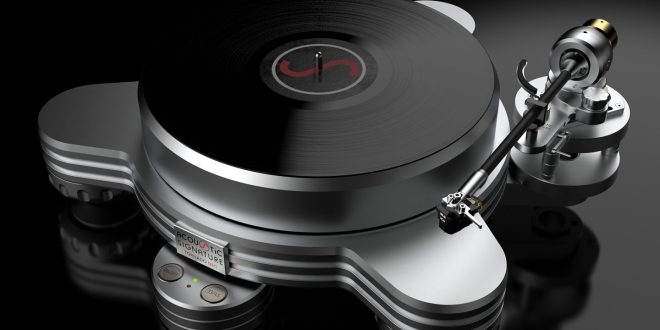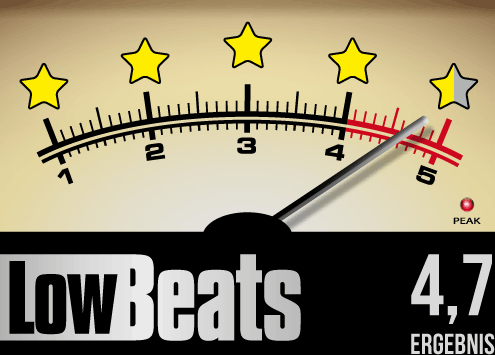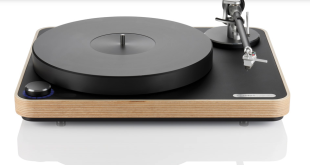In this test, the Acoustic Signature Tornado Neo is not only intended to provide pleasure. Because it provides a base for up to three tonearms, it will also help answer an old analog question: What exactly is the benefit of a twelve-inch tonearm compared to one that is only nine inches long?
A colleague recently wrote that Acoustic Signature is located “near Stuttgart”. This is not entirely incorrect if you define a 50km radius as “nearby”. Anyone with a little more detailed knowledge of southern Germany will be able to locate the signature home of Süßen more precisely: a few minutes away from Göppingen, and therefore almost in the Swabian Alb. In that village they speak a different dialect there than in Stuttgart. After having spent ten years here and there, I’m also sure: it’s the nicer one. There is already better beer, a brewing and drinking tradition with a noticeable but not yet penetrating Bavarian flavor. My drinks dealer in another village not far from Süßen shocked me at my first audition after moving here with a deposit crate central massif of lager and wheat beer that reached almost to the horizon. Pils (Pilsen-style beer) – or “Pls” in local pronunciation? “Han i au” (“Do we also have”), but from that less than non-alcoholic wheat beer, for example.
The climate is also better on the edge of the Alb. But that is of course a matter of taste. The quality of the turntables built by Gunther Frohnhöfer and his employees in Süßen, on the other hand, is beyond any individual sensitivities. In one of the cleanest, most professional establishments I have ever seen from the inside in my long career as a tester. The glamorous Swabian metal construction tradition: here it is not only somehow alive, but in the here and now in perfection. The vertical range of manufacture is impressive. Here, aluminum, brass and steel in the form of bars and rods really do enter the factory gate – and leave the company as a highly refined analog work of art. On which even peripherals such as a lift lever or an anti-skating knob can be traced: Through the highly skilled hands of the CNC specialists, watchmakers and goldsmiths working there. Through strategically organized, meticulously labeled intermediate storage areas, to an exceptionally elegant machine park, a kind of high-end metal processing plant. And to its proud owner Gunther Frohnhöfer, who knows every little screw on it, and who designs the tonearms, turntables and pickups that are produced on it.
Acoustic Signatures Tornado Neo: mass & class
Like all Acoustic Signatures, the Tornado Neo is a heavywheight drive. It concentrates the greatest possible density on a reduced tripod turner, which lies in the hand like a solid aluminum block when lifted. Which is basically what it is: The chassis is milled out of the solid in countless machine hours (although Frohnhöfer of course knows the exact number), then sandblasted, anodized and the top finely brushed.
Our example is completely black, but there is also an all-silver and a black and silver bicolor version to choose from. Each of the three legs ends in a large foot, which can be adjusted in height precisely, without play and practically without resistance thanks to the fine thread. Gel inserts in the feet allow the player’s total mass of around 30 kilos to float viscously yet defined on its footprint. The decoupling effect of such constructions is often more a wish than a fact, and some of the heavywheigt player has proved to be surprisingly sensitive to impact sound in the listening room. In some constructions, this is so pronounced that a small Rega player with the total mass of a beach tennis racket right next to it really shows them off.
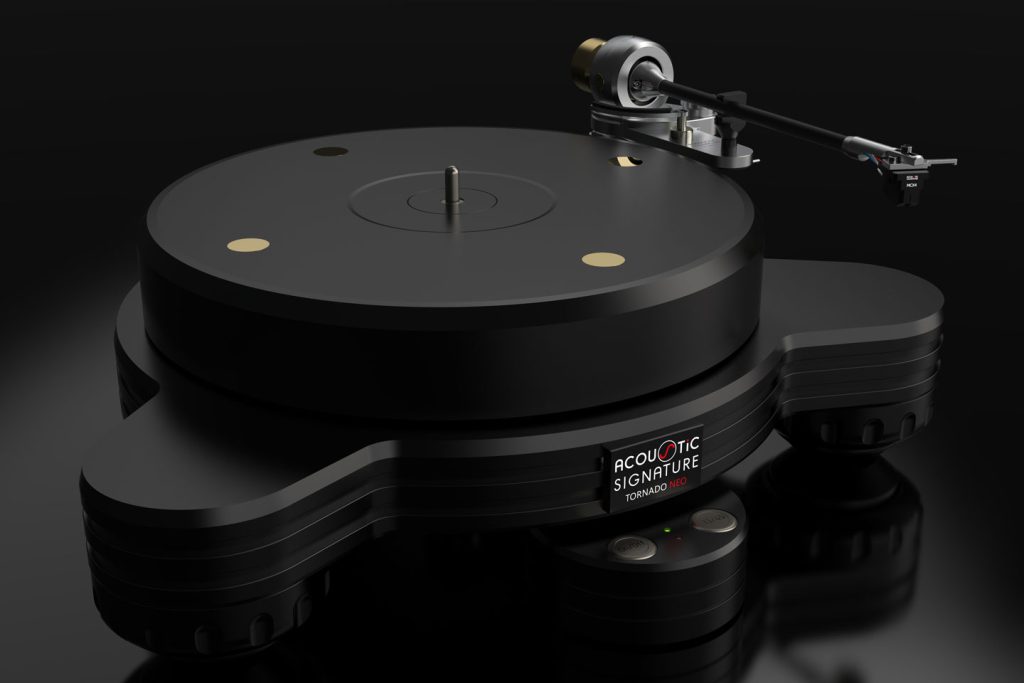
The Tornado expressly does not belong to this disappointing group. It rotates silently and unwaveringly, even under conditions in which you can no longer actually listen to music. The civil engineering company that was laying fiber optic cable in front of the house did me the unasked favor of setting up their entire arsenal of asphalt saws, excavators, vibratory plates and other inferno instruments outside one day. The vibrations that shook the house did not disturb the Acoustic Signature, which continued to play my new Swans record “The Beggar”. You have to get that right first.
Just as heavy and solid as the chassis is the Tornado platter, a six-centimeter-thick disc made of ten kilos of almost solid aluminum. “Almost” because the underside of the platter has a thin insert made of leather fiber-carbon sandwich material. And because of the four silencers pressed flush into the surface. These are cylindrical brass weights, each with two circumferential O-rings that are pressed tightly into the plate. They are used in varying numbers on almost all Acoustic Signature models in order to get rid of the ringing tendency of the powerful aluminum plates.
This already works very well with the four pieces used here: tapping hard on the platter reveals a barely discernible resonance frequency that dies out in a few tenths of a second. The larger members of the Tornado family also put an end to this residual life of their own – with eight silencers in the platter of the Hurricane Neo and 24 of them in the Typhoon Neo. Of course, this also looks successively fancy , especially as the top of the cylinder is not finished in any way, but as a perfect mirror. If that’s not enough, the weights can also be gold or chrome-plated for an additional charge.
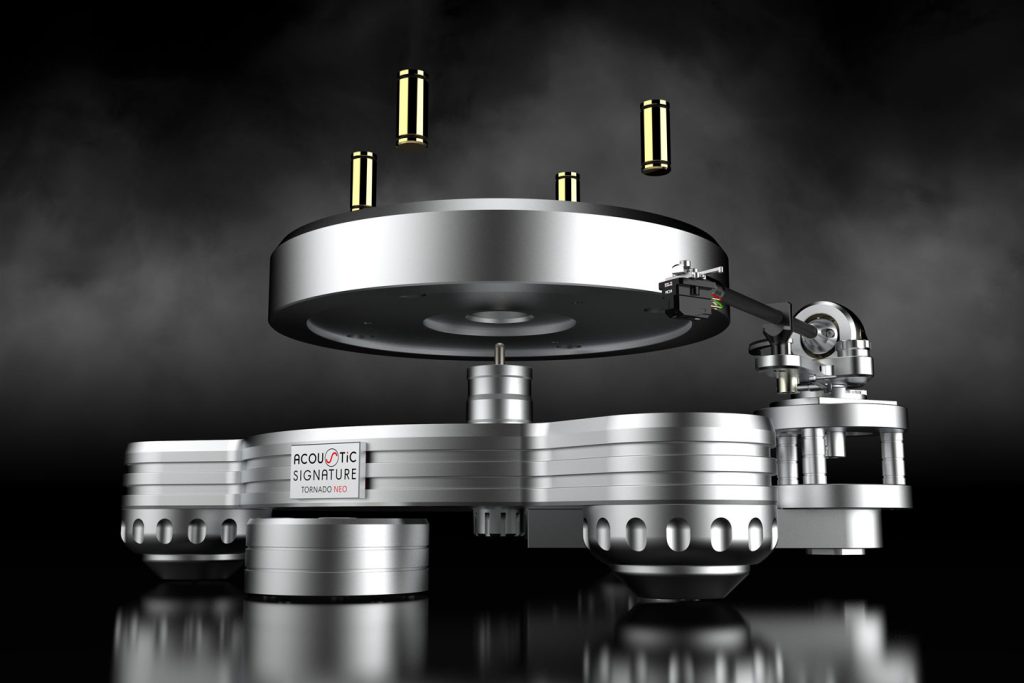
When unpacking and assembling, the heavy round piece must be placed on the disk hub of the drive without causing an accident. There’s also an informative video showing the boss himself unboxing the product. If the process looks really easy and the platter doesn’t look that big, it’s because Frohnhöfer is a giant and does it every day. Acoustic Signature beginners can try out the correct lifting technique over the soft packing foam of the voluminous transport case. Unless the dealer takes care of the assembly anyway, as is usual in this price range. In any case, apart from the high mass, assembly is really uncomplicated. Normally, you do not even come into contact with the sliding surfaces of the bearing or the belt. So ultimately it’s just a matter of placing the platter on the large aluminum hub that protrudes from the player’s driven sub-platter.
This sub-disc is firmly connected to the bearing axle, which rotates in a sintered bronze bushing. Sintered bronze is porous – an important and highly desirable property here because the metal can absorb oil in its pores and thus lubricate itself permanently. Acoustic Signature can even produce the material with extra-large pores. This may make the bronze slightly less resilient – negligible, because the bearing is often oversized for the loads that occur anyway. On the other hand, the larger proportion of pores reduces the contact surface and thus one of the main sources of noise. In fact, the Acoustic Signature bearing runs incredibly quietly and smoothly. This fundamental calm characterizes the entire sound structure in many ways. In addition to obvious symptoms such as absolutely silent pauses between the LP tracks, a superior musical pull also grows out of this calm: Even the quietest, barely perceptible tones and noises seem significant and orderly, as if a giant music magnet had aligned them particularly precisely along the time axis of the piece. It’s hard to describe, but easy to hear within a few turns of the record.
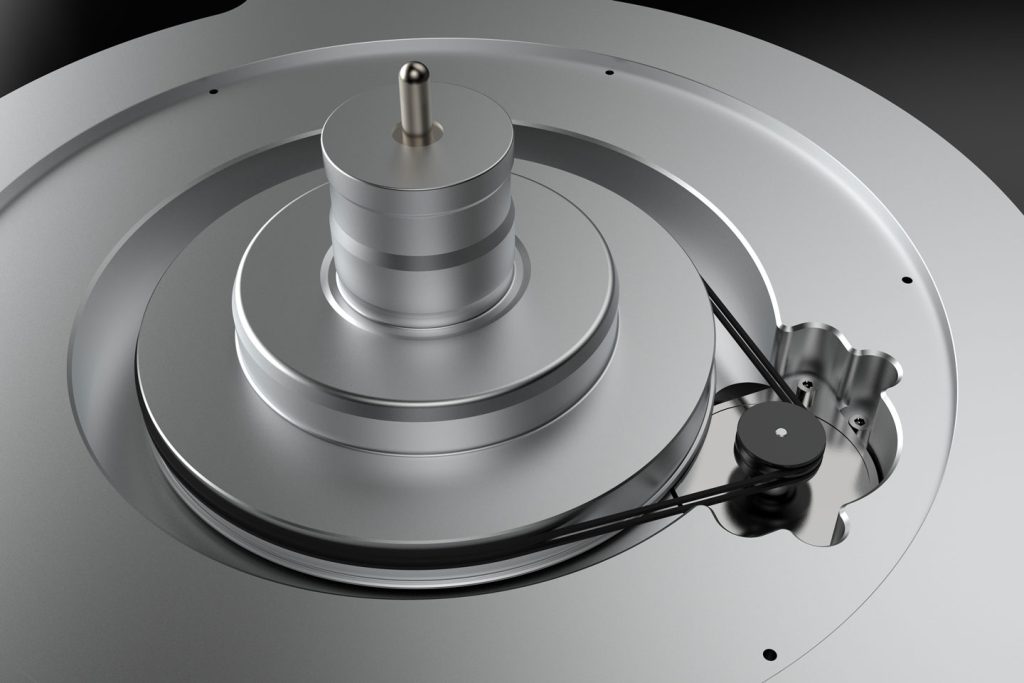
But it’s not just the socket that makes the Acoustic Signature bearing special. But almost more so the axle. It is made of vacuum-hardened stainless steel and is initially produced a tiny bit too large. Only to lose this tiny detail during the next work step: a finishing touch that gives it perfect roundness. Finally, the axle is given a plasma coating of carbon, which is deposited on the material from the vacuum with a diamond-like lattice structure. These coatings are therefore also known as DLC – Diamond Like Carbon – and are characterized by extremely high wear resistance and minimal sliding friction. Which is why not only Acoustic Signature, but also Linn, for example, makes extensive use of it.
Frohnhöfer, which generates a very significant proportion of its sales overseas, calls the resulting bearing “Duraturn Diamond Bearing”, or DTD for short. And it is used in all models – from the entry-level Maximus Neo for just over 5,000 euros without a system to the mighty Invictus Neo, which can easily approach the 200,000 euro mark. The same assembly of bushing, subplate and axle. The Tornado therefore offers a – perhaps slightly less narrowly selected – Invictus stock at a Swabian price. The bearing base is made of the Teflon plastic-metal compound Tidorfolon, which has proven itself in this position in Acoustic Signature players for over 15 years. As practically nothing else has broken during the time “out there” with the customer, the Swabians recently extended the warranty to a decade and a half – for the entire player, not just the bearing.
With the Tornado Neo, we are still relatively low down in the range of models from the southerners. There used to be even smaller models, such as the incredibly well-made Primus for well under 2,000 euros. Acoustic Signature has given up the field. And understandably so. The ratio between production costs and sales was simply too unfavorable; the plant is fully booked even with the current, expensive lineup – as well as some exclusive OEM orders. And with the Tornado Neo, there is no feeling of lacking value for money. All of the manufacturer’s achievements can already be found in this turntable: the DTD bearing, the silencer technology in the platter, but also the outstanding surface quality and the harmonious design – features that did not appear overnight at Acoustic Signature either, but have grown through constant further development. This also applies to the control of the synchronous motor installed in the Tornado, which always keeps the unit at an optimally low vibration level. To do this, the power supply unit adjusts the phase position of the two generated drive sinusoidal voltages in real time.
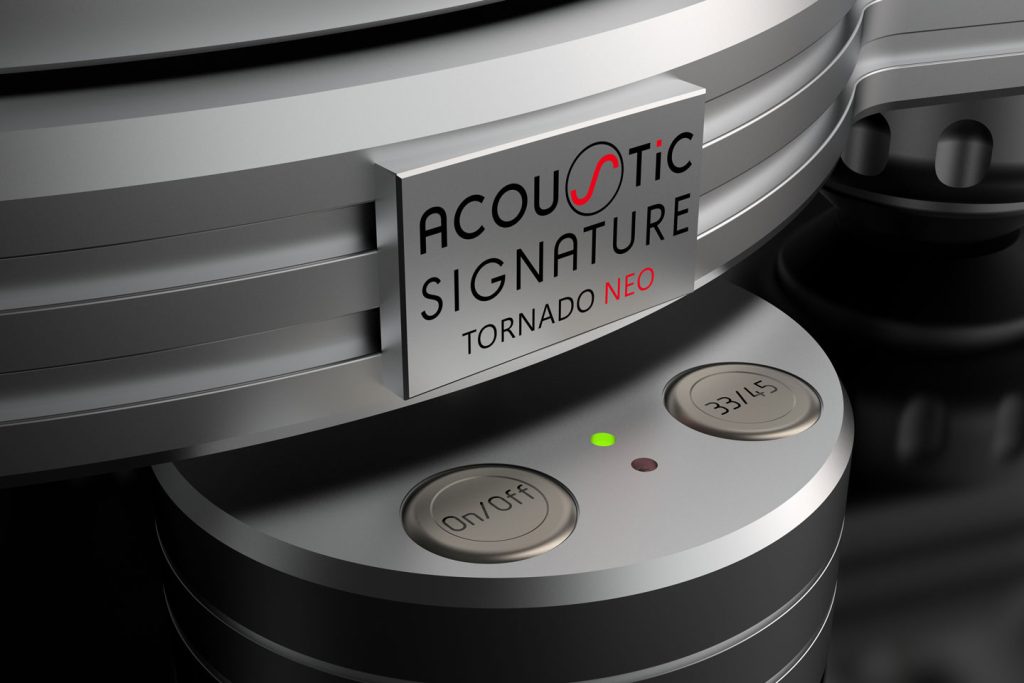
It doesn’t matter where the rather large power supply unit is located. It does not have its own control elements, but stores them in a compact control puck made of solid aluminum, which can be placed freely in front of or next to the player. Two round buttons are recessed there, somewhat reminiscent of vandal-proof doorbell buttons at the entrance to a private bank, but here they are laser-labeled with “Speed 33 / 45” and “On / Off”. The left button changes the speed, the right button starts and stops the engine – which the control unit acknowledges with a sonorous, confidence-inspiring relay “Clong!”. The player then takes a little time to run up. It gradually increases the engine power at the beginning and reduces it again once the target speed has been reached. This protects the belt and minimizes interference. Who then actually shine with their complete absence. The engine could just as well be on another planet. But it does not. Instead, it works deep in the heart of the Tornado under a dust-tight aluminum hatch that only needs to be accessed every few years to replace the ground square belt. If the plate rotates at the correct speed after just under half a minute, the Tornado owner only has to choose one of the mounted arms.
Depending on budget and user, the Tornado Neo can accommodate up to three tonearms. The corresponding bases are simply attached to the bottom of the chassis with two fat Allen screws and can be moved to any distance from the center mandrel. Existing arms, regardless of geometry and bore, are therefore guaranteed to be adequately accommodated. A base is included in the basic price. We increased to two. Because it’s just cooler and we don’t have to pay for it…
And by the way, to find answers to a popular vinyl discussion: What influence does the effective tonearm length – typically 9 versus 12 inches – have on the sound if all other factors remain unchanged? Acoustic Signature offers the ideal playground for this – with six of its own tonearm models, five of which are available as nine- or twelve-inch models. And with in-house MC cartridges, whose technical basis comes from Ortofon, but which are individually measured again in Süßen with precision optics to ensure the tightest possible tolerances.
Nine- or twelve-inch tonearm?
Our setup consisted of two examples of the still moderately expensive TA-1000 Neo, which matched the Tornado well, as well as two identical samples of the MC top model MCX-4 with consecutive serial numbers. Connection cable the same (Audioquest Golden Gate, series on TA-1000 Neo), phono preamp the same(Rike Audio Natalija MC 2), amplifier and speakers the same(Unison Simply 845 with Tannoy Legacy Eaton). And as far as possible, equal adjustment of the two MC systems. This is not particularly difficult, because Acoustic Signature supplies a truly lavish gauge that determines the mounting distance of the arm as well as the overhang and offset angle of the system.
At this point, we need to take a quick look at the theory behind the arm’s length discussion – and what kind of influence is to be expected in the first place. Rotary tonearms only ever approximate the ideal scanning geometry because they swivel the needle on a circular arc over the plate radius instead of moving parallel over it, as the cutting machine does. Their cutting head is therefore always positioned exactly at right angles to the radius of the plate (or the wax or metal master blank). But not the needle afterwards during playback: If you set it at a point on the record exactly at right angles to the radius (i.e. tangential to the groove), and then move the arm further outwards or inwards, the needle also rotates a little out of the ideal tangential position. Thanks to a precisely calculated crank of the arm, i.e. the position of the pickup turned slightly sideways towards the bearing, there are at least two places on the recorded surface of the record where the stylus is exactly tangential. Between these zero crossings, however, there is a deviation called the tangential tracking error angle, which is in the small single-digit degree range for properly adjusted nine-inch arms.
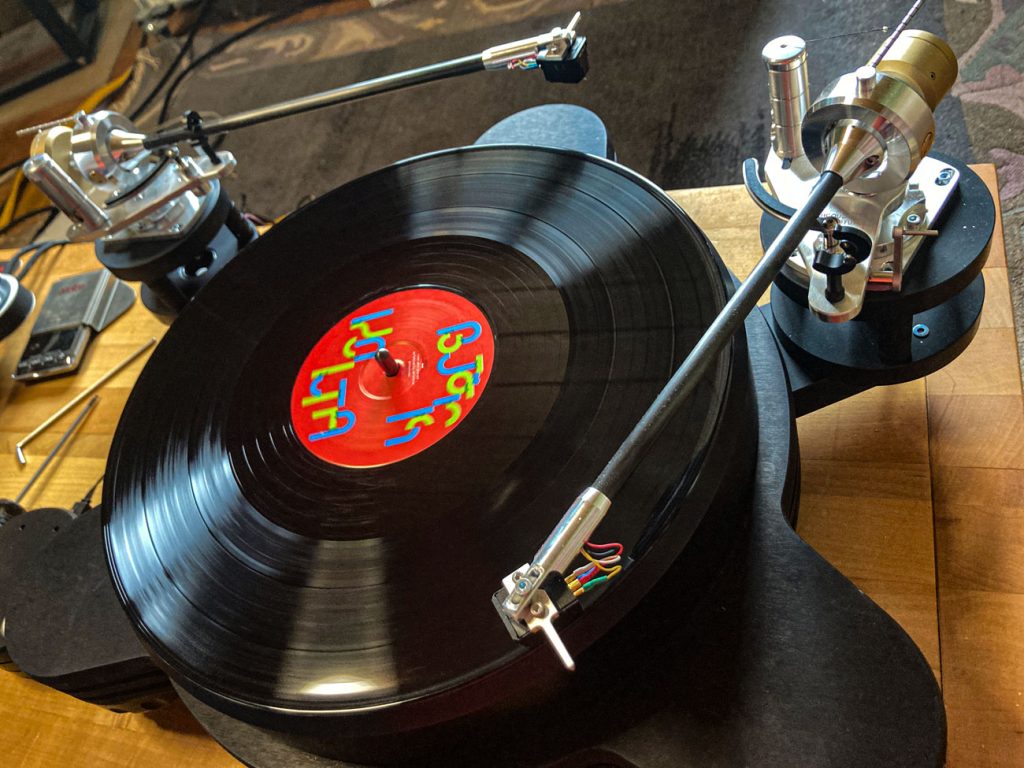
It is obvious that the longer the arm, the smaller the tracking error angle. A hypothetical, infinitely long arm would have none at all. But even the step from the standard length of 9 inches (just under 23 centimeters) to a 12-inch arm with an effective length of 30 centimeters significantly reduces the tracking error – and thus also the distortions caused by this slight canting of the needle.
However, the situation is not quite so clear-cut: long arms also have disadvantages. Their long tubes, for example, are much more torsion-friendly, even though their design is otherwise the same, so they show a more pronounced life of their own when they are excited by airborne sound or the scanning process. In addition, the distortions caused by the tracking error angle consist almost entirely of the first harmonic wave k2, which is hardly noticeable from an aural perspective. At the latest when moving from 12-inch to even longer fishing rods – Clearaudio even had a 16-inch model – the question increasingly arises as to whether you are not tilting at acoustic windmills and creating very real new problems in the process.
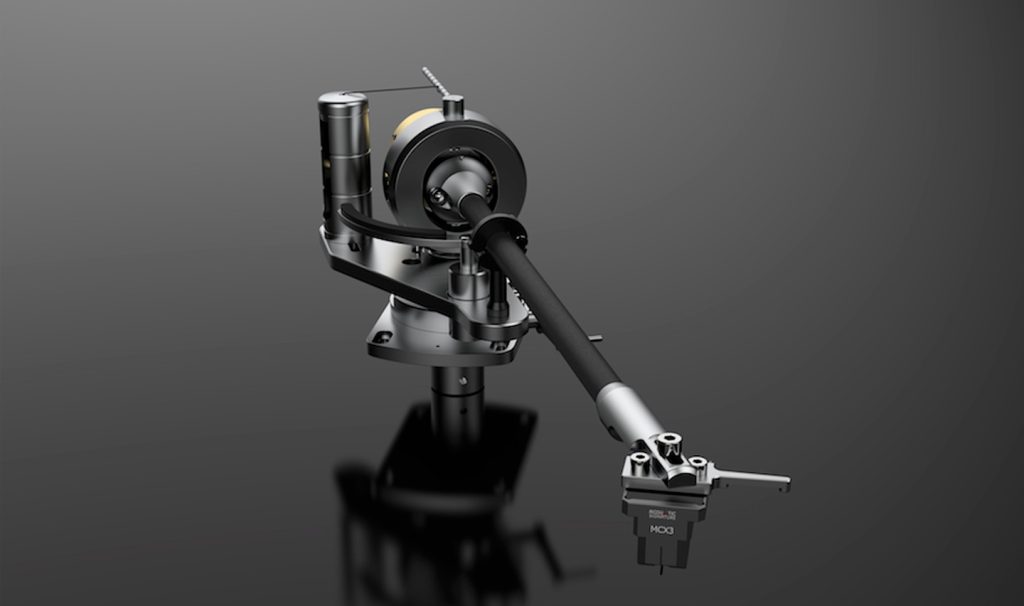
After all, there are also secondary and indirect effects that sometimes speak for and sometimes against additional length: The effective mass of the arm naturally increases with length if the design remains otherwise unchanged. However, this effect is of secondary importance with the TA-1000 Neo, because even the twelve-inch model, at 12.3 grams, is still in the middle of the medium-heavy range, which is almost universally suitable for MM and MC systems. The arm owes its relatively light structure to its slim but very rigid tube made of parallel-oriented carbon fibers laminated into shape in a continuous process (pultrusion).
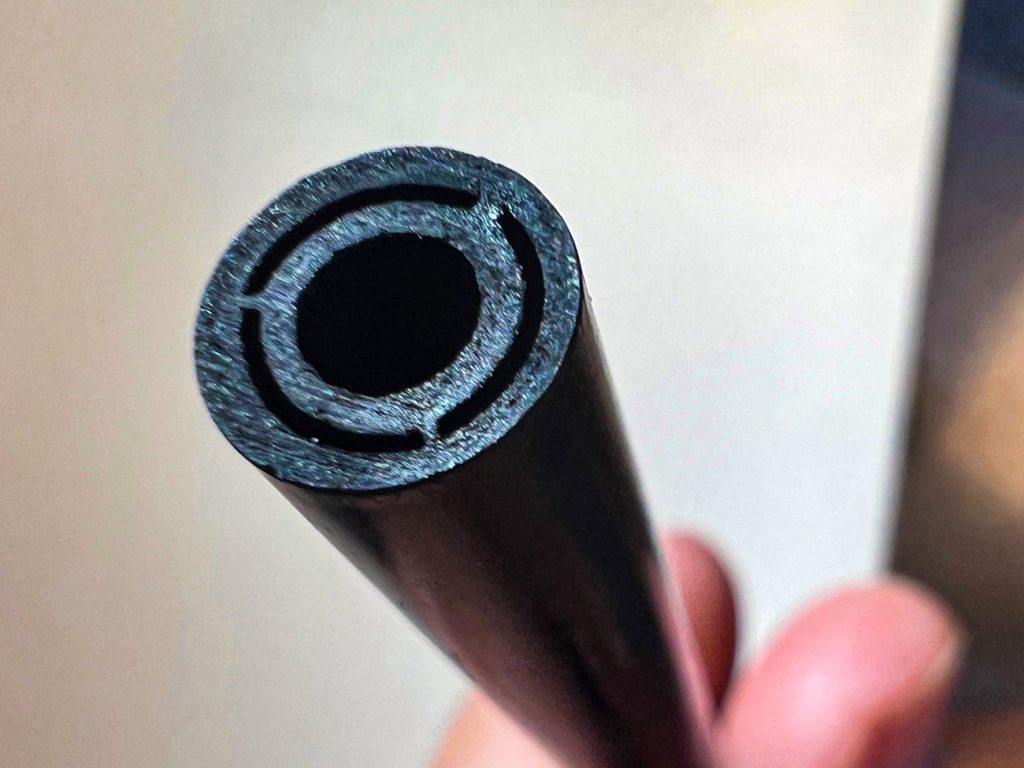
The tube is not simply hollow, but effectively a double tube with radial webs that connect the inner and outer tubes. At the front, it ends in a minimalist headshell with a large adjustment range, which also includes the crank angle due to the design. This is due to the central screw that holds the system carrier: If you open it, both parameters always slip at the same time. Testers who are constantly changing systems probably may lack the opportunity to make small corrections to the overhang, for example, without having to unpack the original gauge again. Normal users, on the other hand, don’t care.
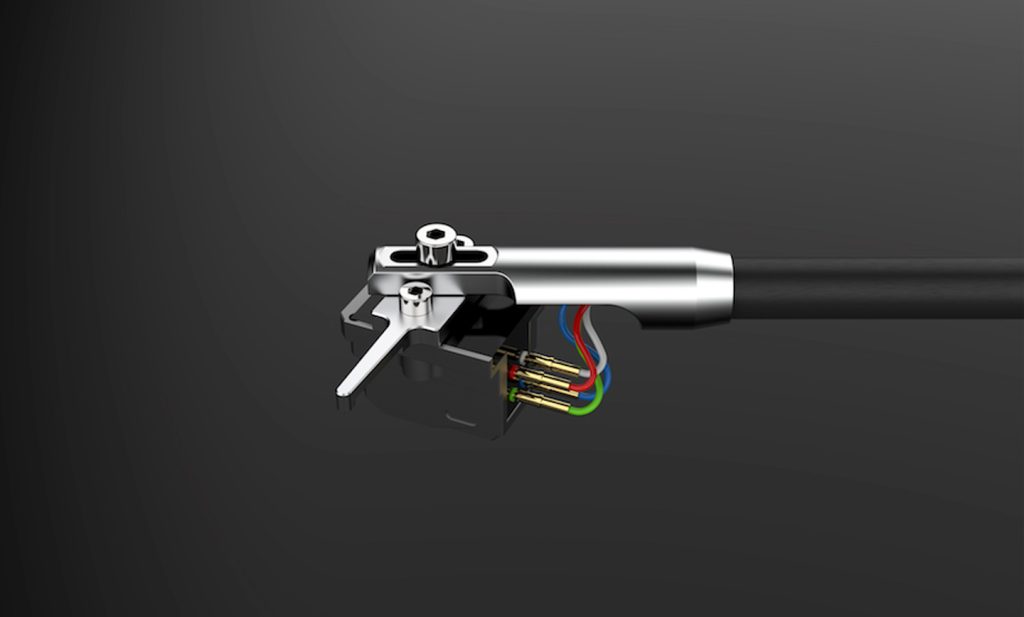
Hearing test
What everyone is interested in, however, is the sound of the two-armed player – and which of the two outriggers now wins the race. The first thing that strikes you is the almost magical calm that the player brings to any music. Not as a calming of the dynamics, but in the form of a wide, almost immeasurably deep stage background into which the acoustics of the recording can spread unhindered. Take the lush string arrangements recorded in London’s RAK Studios on “The Car”, the new Arctic Monkeys album, which unexpectedly turns out to be an audiophile masterpiece. Or the similarly spacious acoustics, which already sound “expensive” without a large instrumental presence, in which Lana Del Rey’s album “Lust For Life” takes place. Del Rey’s voice takes pride of place over the Swabian player, far ahead of the accompanying musicians. This depth also distinguishes the Tornado Neo in the price class comparison – with the implied downside that some competitors do not model the music quite as deeply, but even warmer and more substantial.
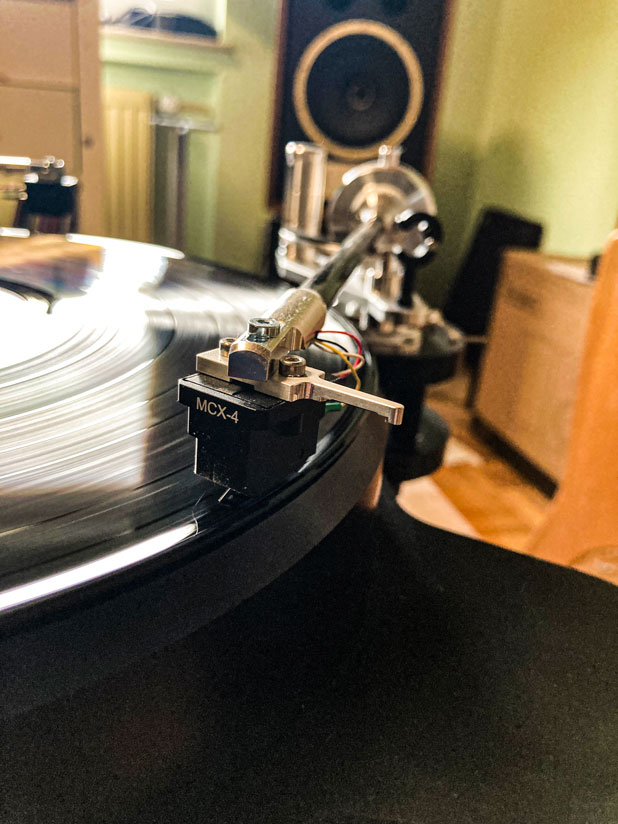
No resonances can be detected aurally. Neither as unacceptable coloration of the sound, nor by deliberately tapping on different parts of the player with the needle in place but the record stationary. Again, the decoupling from the background is remarkably good: I had to drum very forcefully on my Tabula Rasa rack to generate any significant reverberation in the speakers. The best of the “real” subchassis-players can do this even better. My LP12 also ignores hammer blows on the rack floor without any acoustic effects. However, in the “inertia drive with damping feet” category, the Acoustic Signature is definitely one of the least sensitive candidates.
However, neither feet nor sub-chassis protect against airborne sound, for example when listening to loud music. The player is definitely stimulated, especially if he has to play without a hood like the Tornado (and practically all other mass drives too). Now it depends on what it does with the captured sound energy. Gunther Frohnhöfer is convinced that this is also a dirty secret of the twelve-inch arms: The long tubes simply capture more sound energy. In addition – and independent of the volume – there are the vibrations of the needle in the groove. On the one hand, they are necessary, because otherwise there would be no signal in the pickup. On the other hand, this force (like all forces in the universe) cannot exist without a corresponding counterforce, which in this case acts on the groove walls and causes them to vibrate. And which, on the other hand, shakes the arm that holds the system. More carbon tube here means that the arm can also yield more, i.e. vibrate more.
Nevertheless, I liked the sound of the twelve-inch tube very much, and I would definitely want to have a long arm on “my” Tornado. My number one choice for everyday use would be the short TA-1000 Neo. The nine-inch speaker appears a touch brighter, with wider and more detailed spatial imaging. On the twelve-inch arm, the same MCX4 with the same sapphire needle carrier and Shibata diamonds plays more full-bodied, somewhat rounder and more closed in tone (which I like), but spatially not as wide and subjectively not as lively as on the short arm.
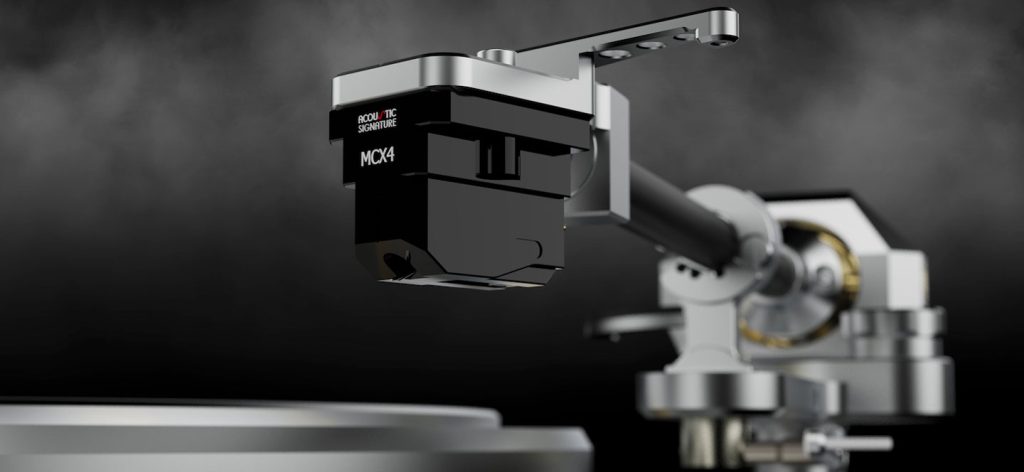
The difference is more noticeable than I would have expected, and it remains the same when I swap the two MCX4s across. There are, however, records that are down to the last few percent of low distortion that the twelve-inch can achieve compared to the nine-inch. Vocals with particularly cymbal (sound from Turkish zills or cymbals, used in belly dances) sounding sibilants (Kate Bush – Hounds Of Love), high-pitched choral music (Veljo Tormis – Forgotten Peoples) – the somewhat defensive driving style of the long 1000 seems to be the best way to go. And then also with completely different pickups. After all, the TA-1000 is one of the few long arms that can also guide somewhat softer MMs with its effective mass. A Nagaoka MP-500, for example, which was lying around because of another test, or the Audio-Technica VM740ML, both of which are tuned very slightly bright and compensate to some extent for the somewhat more introverted sound of the twelve-inch. And which shine with scanning capabilities that are very difficult to achieve with MCs.
Conclusion Acoustic Signature Tornado Neo
So the need for a two- or even three-armed player arises quite naturally in the uncompromising analog household. Which I can definitely call Acoustic Signature. And not just out of love for my old Swabian homeland, but because perfect mechanical engineering and a tuning free of airs and graces guarantee maximum long-term listening pleasure.
Rating
Sound QualityUsabilityBuild QualitySummary |
| The rating always refers to the respective price category. |
| | Sensationally smooth running |
| | Absolutely problem-free handling, compatible with almost every toanbnehmer |
| | Outstanding workmanship |
| | Overhang and offset on TA-1000 secured with a common screw, no cover hood |
Distribution:
AS-Distribution GmbH
Hillenbrand Street 10
73079 Suessen
www.acoustic-signature.com
Price (manufacturer’s recommendation):
Acoustic Signature Tornado Neo: from 6498 euros
Acoustic Signature TA-1000 Neo: from 1,798 euros
Acoustic Signature MCX-4: 2099 Euro
Additional arm base + armboard as required: 700 euros
Technical data
| Acoustic Signature Tornado Neo | |
|---|---|
| Concept: | Heavyweight drive, belt drive |
| Fitting | Up to three tonearms possible |
| Power supply unit: | DMC-10 (2.6 kilos) outsourced |
| Speeds: | 33 + 45 rpm |
| Dimensions (W x H x D): | 45.0 x 16.0 x 46.0 cm |
| Weight: | 26.5 kilos |
| All technical data | |
With and against:
Test Unison Simply 845: twenty-three heavenly watts
Test: MM/MC phono preamp Rike Audio Natalija
Test Audio-Technica VM740ML: the classy way to listen



